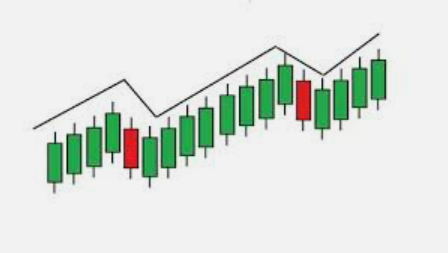
Larissa Barlow
Apr 22, 2022 17:09

Low float stocks offer day traders a great potential to make consistent profits throughout a single trading session. As there are a relatively limited number of shares in low float stocks, their price tends to vary quickly and readily.
Due to the increased volatility, they are an ideal investment opportunity for day traders, particularly for market participants capable of trading in large quantities.
Low float stocks are a widespread and generally popular type of stock traded on all major markets globally. Let us learn how to profitably day trade equities with a low float.
The amount of shares available for trading in a given stock is the floating stock. Stocks with a low float have a small number of outstanding shares. The floating stock of a business is computed by deducting closely held and restricted stock from the total number of outstanding shares.
Insiders, significant shareholders, and workers possess closely-held shares. Insider shares that cannot be traded due to a temporary restriction, such as the lock-up period following an initial public offering, are considered restricted stock (IPO).
A stock with a small market capitalization will generally be more volatile than a large market capitalization. Few shares are available, making it more difficult to find a buyer or seller. As a result, spreads become more expansive, and volume frequently decreases.
The float of a firm is critical for investors since it represents the number of shares genuinely available for purchase and sale by the general investing public. Typically, a low float is a barrier to an active trade. Due to this lack of trading activity, investors may find it difficult to initiate or exit positions in companies with a small float.
Institutional investors frequently avoid trading in businesses with lower floats due to the limited liquidity and higher bid-ask spreads. Rather than that, institutional investors (such as mutual funds, pension funds, and insurance companies) who purchase huge stock blocks will seek out companies with a larger market capitalization. If they invest in companies with a substantial market capitalization, their significant acquisitions will have a minimal effect on the share price.
Low float stocks are those issued by corporations with a significant amount of institutional ownership that remain available for trading on the market. For instance, if a corporation has 100 million total outstanding shares and 90 million restricted stocks (also known as closely held), 10% (10 million) of all shares are low float and eligible for public trade.
Typically, businesses issue closely-held stock owned by significant stakeholders, workers, and other insiders. The majority of equities remaining for public trading (about 10%–15% of total float) are low float stocks.
Because of the fact that low float stocks often have a small number of shares, they are more volatile. On the other side, this presents a favorable chance for day traders because of the frequent price changes of up to 100% and the possibility of more significant returns.
Low float equities are traded several times in massive quantities throughout the trading session. For instance, a stock with a low float of 500 000 shares will fluctuate far more rapidly than a stock with a float of 10 million shares.
While the first can be easily changed with less purchasing power, it is more challenging to alter the instrument's price with a larger volume. Another hallmark of low float stocks is their relatively broad bid/ask spread.
A high float stock is one in which the great majority of the total number of outstanding shares of a corporation are freely traded. Numerous S&P 500 corporations are examples of this, with highly dispersed ownership and insiders typically holding modest stakes in the company. The longer a company's stock has been publicly traded, the more freely its stock will float.
By comparison, a limited float stock contains insiders who own a significant portion of the total outstanding shares. Is a little float detrimental to a business? Certainly not. Indeed, this is frequently a sign of convergence between insiders and their public shareholders. Confident investors choose to invest in businesses where the founder or a member of the founder's family controls the company.
On the other side, a large stock float can be helpful because it increases liquidity and results in lower share price volatility. Short-term traders have a considerably more challenging time manipulating or disrupting a company's share price with a large float than they do with a small float.
The company recently went public: Generally, when a company goes public for the first time, a significant portion of its existing shareholder base is barred from selling for a specified amount of time following the IPO.
The company went public via a SPAC: It is not uncommon for Special Purpose Acquisition Companies (SPACs) to acquire a tiny portion of a company's total outstanding stock. This leaves the previous owners with a significant fraction of the total number of outstanding shares.
The Business Is Family-Controlled: There are countless businesses in which the founding family retains majority ownership. It lists a minority part in the firm to facilitate liquidity and create a public market for shares, but insiders retain the majority of stock.
When founders die, they frequently leave a sizable percentage of their holdings to a linked charitable foundation. While the charity retains ownership of these shares, they are generally omitted from the float.
The Business Makes Use of Stock-Based Compensation Significantly: A large number of technology businesses compensate their personnel in part through the restricted stock and stock options. These shares do not become available for trading until they vest and become freely tradeable.
A Company Buys Back Massive Amounts of Stock: Some companies actively buy back stock, significantly reducing the number of outstanding shares and boosting insiders' proportionate share ownership.
While not every low-float stock is a solid buy, this is a common-day trading approach. Day traders frequently consider several additional considerations when evaluating a low-float stock.
The relative volume indicator depicts a stock's current volume compared to previous periods.
This is critical for investors because it can affect a stock's liquidity. If a stock has poor liquidity, traders may find themselves with shares they cannot sell.
Additionally, they may find themselves unable to profit from news catalysts that result in a significant buy or sell the move. If the price of stock swings significantly yet there is little trading volume, it may not be a good option.
Favorable or unfavorable news about a firm sometimes causes a low float stock to soar or decline rapidly.
Day traders monitor the stock market and business news closely to determine which equities are likely to make a move. Due to the scarcity of low-float stocks, a single news event can lead them to rise anywhere between 50% and 200 percent in a single day.
This is a proportion of the total number of accessible shares of stock. Each trader has a preferred float percentage, and however, the majority prefer a percentage between 10% and 25%.
When trading stock with a low market capitalization, a trader may purchase and sell the same stock numerous times in a single day. In an extreme type of market timing, the following day switches to new low-float stock.
Many traders will pre-plan their profit targets, support and resistance levels, and stop losses in order to minimize risk. As with every trade, traders can use technical indicators such as candlesticks and moving averages to determine whether a stock is bullish or bearish.
Locating and evaluating potential trading stocks involves some expertise and experience. Numerous platforms enable traders to trade low-float stocks. Several of these systems enable traders to search for the most outstanding chances based on variables such as volume and float. Traders should hunt for low float equities with less than 50 million market capitalization and a high volume.
Low float stocks give traders some particular challenges, as does any investment.
Stocks with a low float have high volatility and can move substantially at a price within seconds or minutes. If an investor is not cautious, intelligent, or constantly vigilant, this volatility can wipe out a significant amount of their capital. Low-float equities may offer significant profit potential, and traders may experience daily gains of up to 200 percent.
It is critical to consider both news and technical indications when trading. Trading low float stocks necessitate a regular review of market news since the perfect stocks for trading one day may be unsuitable the next.
Rand Capital Corporation's stock has returned investors 59% in the last year. The company is a New York-based business development organization. It has a market capitalization of more than $43 million and generated revenue of more than $3 million last year. The firm invests in small and medium-sized enterprises, preferring those in the technology sector developing a novel product or service.
Rand Capital Corporation stated in 2021 that it had invested over $4.5 million in two new portfolio companies. The corporation disclosed that the investments were made via debt instruments with equity components.
Rand Capital Corporation had previously stated that the company's board of directors had declared the company's first regular cash dividend to shareholders. According to the corporation, the cash dividend was 10 cents per share and was payable at the end of the month.
Over the last six months, PrimeEnergy Resources Corporation stock has returned 22% to investors. Oil and natural gas are produced and sold by the company. It is based in Texas. Oklahoma, Texas, and West Virginia are all states where the corporation operates. It owns around 700 wells in these locations and has a stake in another 800. It began operations in 1973. Along with exploration initiatives, the corporation enters into joint oil partnerships with industrial partners.
PrimeEnergy Resources Corporation announced first-quarter results of -$0.73 per share on revenue of more than $14.7 million. The company's market capitalization exceeds $105 million.
NCS Multistage Holdings, Inc. is a Texas-based company specializing in marketing engineered products and related support services. Over the last year, investors have earned gains of more than 166 percent on the company's stock. This company was created in 2006 and now has about $74 million in market capitalization. Among the goods sold by the company are sliding sleeves inserted in the casing, downhole frac isolation assemblies, sand jet perforating equipment, and spot frac systems.
NCS Multistage Holdings, Inc. reported first-quarter earnings per share of -$1.18, beating market expectations by $0.22. Revenue exceeded $28 million during the period, exceeding projections by $0.5 million.
Among the hedge funds tracked by Insider Monkey, Renaissance Technologies of New York is the largest shareholder in NCS Multistage Holdings, Inc., with 8,111 shares worth more than $225,000.
Village Bank and Trust Financial Corp. have provided investors with more than 59% gains during the last year. The firm is headquartered in Virginia and serves as a bank holding company; and it began operations in 1999. Commercial and mortgage banking services are available at the bank, and Chesterfield, Hanover, Henrico, Powhatan, and James City are among the bank's counties.
Village Bank and Trust Financial Corp. (NASDAQ: VBFC) has a market capitalization of more than $68 million and generated revenue of more than $32 million last year. The stock's 52-week range is between $28 to $62. It now has a short interest rate of 0.31 percent.
Minerva Advisors, a Pennsylvania-based hedge fund, is the largest shareholder in Village Bank and Trust Financial Corp. (NASDAQ: VBFC), with 24,745 shares valued at more than $968,000.
Seneca Foods Corporation, headquartered in New York City, is a packaged fruits and vegetable marketer. The company's shares have generated more than 38% returns during the last twelve months. Seneca, Libby's, Aunt Nellie's, READ, Green Valley, and CherryMan are just a few of the brands under which the corporation offers products. The company was based in 1949 and exports to more than 90 countries.
Seneca Foods Corporation reported earnings per share of $1.63 and revenue of more than $304 million for the fourth fiscal quarter, a decrease of 1% from the same period last year.
The stock of China Finance Online Co. Limited (NASDAQ: JRJC) has returned investors 11% in the last six months. The company is headquartered in China and offers financial services via the internet. It began operations in 1998. The company provides various financial services, including securities trading, wealth management, investment advisory, database and analytics solutions, and other financial products. It has a market capitalization of approximately $22 million.
China Finance Online Co. Limited reported fourth-quarter earnings of -$0.05 per share on revenue of more than $9.7 million, up 12 percent year over year.
Investors have received a 108 percent return on their investment in Flanigan's Enterprises, Inc. over the last twelve months. The business owns and operates full-service restaurants as well as package liquor stores. Its headquarters are in Florida. It owns a market capitalization of more than $56 million and revenue of more than $112 million last year. It was founded in 1959 and currently operates close to 30 restaurants and retail locations, most of which are in South Florida.
This company reported second-quarter earnings of $1.32 per share and more than $34 million in revenue, an increase of nearly 14% over the previous year's second-quarter revenue.
The stock of HMG/Courtland Properties, Inc. has returned investors 53% in the last year. The company is founded in Florida and specializes in owning and managing income-producing properties. It began operations in 1971. The firm's marketable securities portfolio includes preferred and non-preferred equity in large real estate investment trusts. This company owns a market capitalization of more than $16 million and reported revenue of more than $80,000 last year. The stock's 52-week range is between $9 and $33. It has a short interest rate of 1.36 percent.
HMG/Courtland Properties, Inc. is one of the stocks that stand to benefit from the economy's reopening. The company primarily manages and owns commercial properties that were shut down during the pandemic's lockdowns.
This company is a food and transportation company headquartered in Kansas with solid ties to the agriculture industry. The company's stock has provided investors with more than 37% returns over the last year. The firm is uniquely positioned to benefit from a record rise in soybean and corn prices due to a Chinese buying spree. It owns a market capitalization of more than $4.5 billion and revenue of more than $7 billion last year.
Seaboard Corporation declared a quarterly dividend of $2.25 per share, consistent with previous quarters. The firm reported quarterly revenue of more than $2 billion the same day, up more than 22% yearly.
This is one of the best low float stocks to invest in right now. Over the last twelve months, the stock has generated more than 134 percent returns for investors. The company is headquartered in Nebraska and engages in the wholesale distribution of consumer products. Among the products distributed by the company are tobacco products, candy, beverages, groceries, paper, and skincare products. The company owns and operates over 20 health food retail locations.
AMCON Distributing Company reported fourth-quarter earnings and revenue of more than $438 million, an increase of more than 10% year over year. In April, the company declared a quarterly dividend of $0.18 per share, representing a 0.51 percent forward yield.
The stock float is critical in determining the size of a company's shareholder base. If a company has a low float, it may indicate a solid ownership base with significant participation from executives and directors. Additionally, it may result in more volatile and unpredictable trading conditions for a stock with a small market capitalization.

Apr 22, 2022 17:07

Apr 22, 2022 18:04